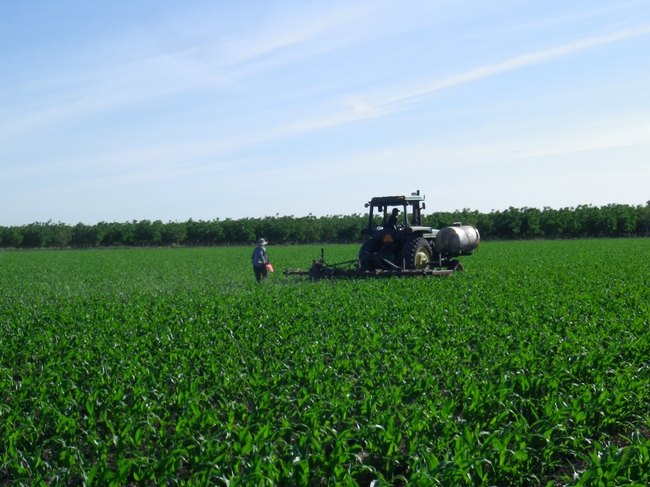By Jordon Wade
In order to be accurate and effective, fertilizer recommendations must factor in a wide range of considerations, ranging from the site-specific to the climatic. To help guide these decisions, “the 4 R's” have been developed: Right rate, Right place, Right time, and Right form. These 4 R's can be utilized in tandem to maximize a given goal, whether that is maximum yield, maximum profitability, minimize adverse environmental effects, or perhaps a combination of factors. However, the specific recommendations will vary according to farm- or field-specific factors, such as climate, soil mineralogy, crop choice, or labor constraints. As such, it is difficult to make “best management” prescriptions across regions.
Several UC Davis researchers—Hannah Waterhouse, Martin Burger, and Will Horwath—recently investigated the 3 of the 4 R's of corn production over two years (2013-2014) on a farm near Stockton in the San Joaquin Valley. They were particularly interested in how nitrogen fertilizer rate, placement, and timing affected nitrous oxide (N2O) emissions. Additionally, they were comparing emissions and yields between drip and furrow-irrigated corn.
Right Rate: For both years of this study, fertilization rates were adjusted using the preplant (or residual) nitrogen levels, which were 65 lbs/ac in 2013 and 77 lbs/ac in 2014. These rates of residual nitrogen were then subtracted from the target fertilization rates to have an equal level of available N across years. To learn more about calculating residual nitrogen rates, visit our page on residual nitrogen budgeting. Overall, emissions increased with increasing rate, although there was a high degree of variability. Yield-scaled emissions, which allow for emissions to be examined in terms of agronomic efficiency, also increased as N rates increased. Using the corn stalk nitrate test in 2014, they found that there was no N deficiency, except a marginal deficiency in the 65 lbs/ac rate. At the highest rates (227 lbs/ac and 307 lbs/ac), the corn stalk nitrate test found hugely excessive levels of plant-available N.
Right Place: They also looked at the effect of applying fertilizer in a single band or a double band. They applied fertilizer at the same rate—202 lbs/ac in 2013 and 227 lbs/ac in 2014—on either the inside (1-band) or both sides (2-band) of the corn plant line. Comparing emissions from the single band vs. the double band, they saw twice as many emissions from the single band in 2013 and 3-4 times as much emissions in the single band in 2014, without seeing any differences in yield. There was also much higher residual nitrogen in the 1-band application, resulting in a higher fertilizer use efficiency in the 2-band treatment.
Right Time: For both years of the study, the majority of the fertilizer was applied as a sidedress during V2 stage of crop growth in 2013 (202 lbs/ac) and during V4/V6 in 2014 (227 lbs/ac). The use of the nitrification inhibitor AgrotainPlus helped to maintain the fertilizer in the less mobile ammonium form for longer, to better sync nitrogen supply with crop nitrogen demand. In the first year (2013), the application of fertilizer and nitrification inhibitor at V2 was a bit too early and did not reduce emissions. In 2014, the fertilizer and nitrification inhibitor were timed better to coincide with crop N demand and reduce emissions by 60%, although no yield difference was observed. This better syncing also resulted in an “excess” reading from the stalk nitrate test, suggesting that fertilization rates could likely be decreased in subsequent years.
These results were supported in another field trial of corn by the same group of researchers in Yolo County, where the AgrotainPlus also decreased emissions by approximately 50% in the sandier, coarser soils. In this study, AgrotainPlus also decreased easily-leached residual nitrate by 10 lbs/ac.
Irrigation Method: In 2013 and 2014, irrigation types were varied in the 202 lbs/ac and 227 lbs/ac treatments, respectively. Using subsurface drip to supply fertilizer and irrigation to the corn resulted in a 50-80% reduction in nitrous oxide emissions, relative to the furrow-irrigated field. The drip also had double the grain yield of furrow-irrigated corn in 2013, but no difference in total yield when growing for silage in 2014.
While the results of this study are subject to much of the same inherent variability associated with agricultural studies, it does support much of the current body of knowledge and show that California is not an exception. The central take-home messages from this research (that are well-supported by other studies) are:
- Testing for residual nitrate prior to planting helps to adjust fertilizer recommendations to minimize environmental effects, such as nitrous oxide emissions.
- Concentrating N fertilizer (especially ammonia/ammonium) into a single applied band will greatly increase emissions and decrease your fertilizer N use efficiency.
- Nitrification inhibitors can substantially decrease nitrous oxide emissions and increase your fertilizer N efficiency. Although they might not increase yields, they have the potential to increase N cycling within the system.
- Using subsurface drip irrigation can increase your yields (especially grain yields) while cutting your N2O emissions in half.
For more on nitrogen budgeting and nitrous oxide emissions, visit our Focus Topic pages.

Source:ucanr.edu